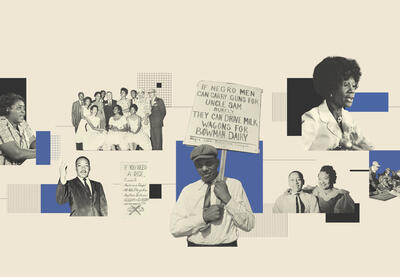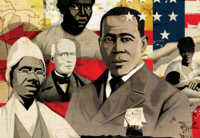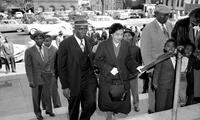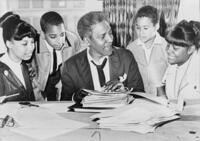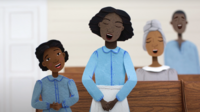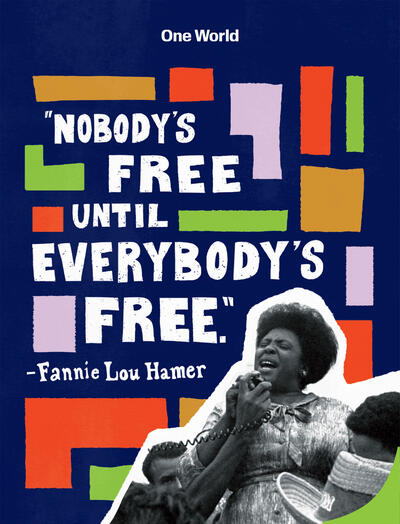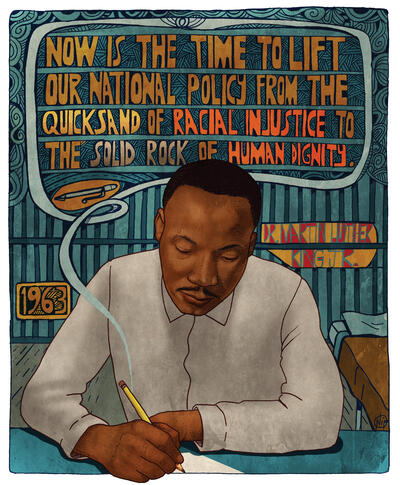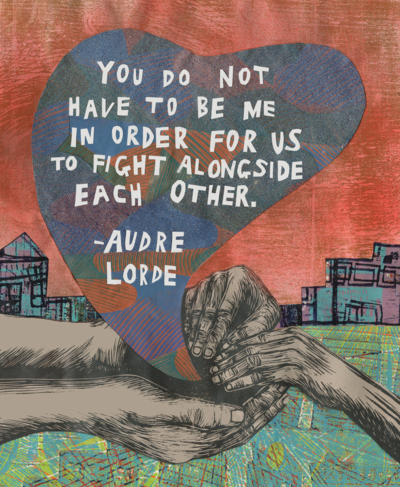Black history is central to our nation’s story. On the one hand, we must understand the foundational role of racism and white supremacy in our nation’s origin, and, on the other, we must celebrate the continuous threads of Black resilience, contribution and triumph at every phase. Young people deserve to learn this history in all its complexity, and in ways that are accurate, comprehensive and age appropriate. Uplift Black stories during Black History Month, of course, but more importantly, incorporate Black history all year long.
“If young people are to make the vision of a just and peaceful world a reality, we must give them the tools to build a strong, multiracial, inclusive democracy—and those tools include an honest and comprehensive history of the United States.”
—from Teaching the Civil Rights Movement
Learning for Justice offers the following resources to help you learn about, teach and make Black history visible.
Resources
Build a Foundation With These Frameworks and Publications
Teaching the Civil Rights Movement
Our Civil Rights Movement framework for grades 9 to 12 supports facilitating a solid understanding of the struggle for Black equality. Teaching the Civil Rights Movement begins in 1877 with Reconstruction and continues the narrative of the movement for equality and civil rights to the present. This publication includes: the Framework, which organizes essential knowledge into four chronological periods; Guiding Principles that provide essential practices to support educators in being reflective and intentional in their teaching; and Resources, which, while by no means an exhaustive list, provide options for teaching each Summary Objective.
Teaching Hard History: American Slavery
Our Teaching Hard History Framework follows the history of American slavery, and the struggle to end it, from precolonial times to the earliest European settlements and through the Civil War and Reconstruction. We offer detailed frameworks for how to approach this topic in both K-5 and 6-12 contexts, as well as a host of classroom resources and professional development materials to help you teach the materials.
- Teaching Hard History: American Slavery | Classroom Videos
In these short videos, historians and scholars explore the undertaught history of African and Indigenous enslavement in what is now the United States. - Teaching Hard History in Grades K-5 (webinar)
This webinar explores how our K-5 Teaching Hard History framework centers the stories of enslaved people to teach the history of American slavery in a way that is both age appropriate and accessible. - Teaching Hard History: American Slavery (webinar)
In this webinar featuring Hasan Kwame Jeffries, Ph.D., participants will dive into Learning for Justice’s Teaching Hard History resources for grades 6-12. These resources are designed to help educators overcome the shortcomings of textbooks and state standards in teaching the history of American slavery.
Advocating for Teaching Honest History: What Educators Can Do
This publication offers concrete tools for educators seeking to ensure future generations receive an accurate accounting of our nation’s history.
Discuss Key Moments and Untold Histories With These Articles
Talking to Children About the History of Slavery in the United States: A Resource for Parents and Caregivers
These recommendations for discussing the history and legacy of slavery and race with children also provide age-appropriate information to emphasize in conversations.
Celebrate African and Indigenous Culture: A Resource for Parents and Caregivers
Conversations about African and Indigenous cultures are essential for learning about the history of our country and making connections with a broader world.
Teaching About the Montgomery Bus Boycott
Grounded in our Teaching the Civil Rights Movement Framework, this article offers guiding principles and suggested resources for teaching about this important campaign.
Remembering the 1963 March on Washington
This article offers resources to help contextualize the challenges and triumphs of the 1963 March on Washington for Jobs and Freedom.
Power of the Vote: Lifting the Veil of White Supremacy, From the Ocoee Massacre to January 6
This article recounts the story of a little-known 1920 massacre against Black voters in Ocoee, Florida, drawing connections between that moment and the January 6, 2021, insurrection at the U.S. Capitol.
What Is Our Collective Responsibility When We Uncover Honest History?
Local history advocates say preservation, education and healing should include community redevelopment and respecting the agency of descendants of enslaved people.
Black LGBTQ History: Teachers Must Do a Better Job
Our curricula should not present a narrow, monolithic narrative about Black history that omits certain voices and identity groups, such as LGBTQ+ individuals.
Connect Voting Rights History to Current Policies and Discourse
Uncovering the honest history of voting rights in the U.S. is crucial to creating an inclusive society and realizing the democratic ideals expressed in the Constitution.
A Supremely Historic Moment
As the first Black woman is appointed to the U.S. Supreme Court, there are lessons we can all learn about intersectionality, representation and our essential roles in eliminating obstacles for young people.
History Moves With Us
Movement veteran Charles E. Cobb Jr. reflects on teaching civil rights history.
Reflections on a Dream Deferred
In 2008, Rep. John Lewis shared his thoughts on Dr. King's dream and the current struggle for equality. This inspiring essay honors both of these leaders.
Teaching About King’s Radical Approach to Social Justice
While Dr. Martin Luther King Jr.’s work is often sugarcoated, it’s important to teach that King championed economic justice and taught Black self-love while also pushing back against neutrality, imperialism and systemic racism.
Deepen Your Knowledge and Teach With Our Podcast, Videos, Webinars and Lessons
Teaching Hard History podcast
From Learning for Justice and host Hasan Kwame Jeffries, Ph.D., this four-season podcast brings us the lessons we should have learned in school through the voices of leading scholars and educators. Seasons 1 and 2 address American slavery, Season 3 highlights the Jim Crow era, and Season 4 takes a deep dive into the Civil Rights Movement.
An Outrage
This film takes viewers to the very communities where heinous acts of violence took place, offering a painful look back at lives lost to lynching and a critical look forward. (Grades 9-12)
Latinx History Is Black History (webinar)
This webinar clarifies the confusion between race and ethnicity, provides a historical primer on Afro-Latinx identities and reviews resources for teaching Elizabeth Acevedo’s poem “Afro-Latina.”
The Color of Law (Lessons, Grades 9-12) (Lesson 1, Lesson 2, Lesson 3)
Based on Richard Rothstein’s The Color of Law, these lessons delve into the legacy of discriminatory housing policies and explore their role in exacerbating the racial wealth gap. The Color of Law webinar explores the role of U.S. segregation in everything from housing to employment to wealth accumulation—and the policies that made it all happen.
Teaching The New Jim Crow
This teacher’s guide for The New Jim Crow: Mass Incarceration in the Age of Colorblindness includes 10 lessons to help engage high school students in conversations about systemic racism past and present. The Teaching The New Jim Crow With Michelle Alexander webinar walks participants through the teaching guide.
James Baldwin: Art, Sexuality and Civil Rights
Baldwin’s life illuminates not just the intersections between gay rights and civil rights but also the connections among self-identification, artistic expression and political activism.
Hidden Figures of Women’s History: Cathay Williams (Text, Grades 6-8)
This text for middle grades highlights the story of Cathay Williams, the first African American woman to serve in the U.S. Army.
Beyond Rosa Parks: Powerful Voices for Civil Rights and Social Justice
Most history textbooks include a section about Rosa Parks in the chapter on the modern civil rights movement. However, Parks is only one among many African American women who have worked for equal rights and social justice. This series introduces four of those activists who may be unfamiliar to students.
The Little Rock Battle for School Integration
In 1957, African Americans in Little Rock, Arkansas, made their city the most significant test case for the United States Supreme Court’s 1954 and 1955 Brown v. Board of Education rulings.
Engage Children With These Resources
“The Shoebox Lunch”
In this story, a young boy discovers an old metal toolbox, a relic from his grandfather’s past, and learns from his grandmother the story of resistance, resilience and love that the box represents.
“The Night Before the Dream”
In this poem for children, Bea’s family travels a long time to hear Dr. Martin Luther King Jr.—and plan how they’ll make his dream a reality. The tale uplifts the value of family and the fight for justice across every generation.
“Freedom Riders”
This story for children introduces the history of the Freedom Riders and tells in age-appropriate ways of how an angry mob beat the Freedom Riders when they arrived in Montgomery, Alabama.
“Songs of Zion”
Intended for younger children, this story and accompanying video highlight the importance of music in the lives of enslaved people, and the continued legacy of African American spirituals in music history and resistance movements today.
“Hercules’ Daughter”
In this story, Young Delia learns a hard lesson from her papa about what it means to be enslaved on George Washington’s plantation.
Uplift Black Voices With These One World Posters
Dr. Martin Luther King Jr.
Main illustration by Israel G. Vargas.
